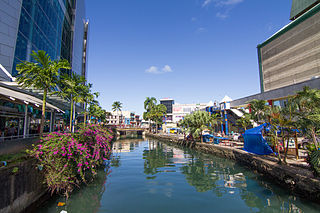
Back اقتصاد فيجي Arabic Economía d'Islles Fixi AST Economia de Fiji Catalan Economía de Fiyi Spanish Économie des Fidji French Economía de Fidxi Galician Ֆիջիի տնտեսություն Armenian Ekonomi Fiji ID Ekonomio di Fidji IO Economia de Fiji Occitan
This article needs to be updated. (October 2020) |
 | |
| Currency | Fijian Dollar (FJD, FJ$) |
|---|---|
Trade organisations | WTO |
Country group |
|
| Statistics | |
| Population | 913,174 (2023 est.) |
| GDP | |
| GDP rank | |
GDP growth |
|
GDP per capita | |
| -2.20%[6] | |
Population below poverty line | 31% (2009 est.) |
Labour force | 353,100 (2017 est.) |
Labour force by occupation |
|
Main industries | Tourism, sugar processing, clothing, copra, gold, silver, lumber |
| External | |
| Exports |
|
Export goods | Fuel, including oil, fish, beverages, gems, sugar, garments, gold, timber, fish, molasses, coconut oil, mineral water |
Main export partners |
|
| Imports |
|
Import goods | Manufactured goods, machinery and transport equipment, petroleum products, food and beverages, chemicals, tobacco |
Main import partners |
|
| |
| Public finances | |
| Revenues | 1.454 billion (2017 est.) |
| Expenses | 1.648 billion (2017 est.) |
The economy of Fiji is one of the most developed among the Pacific islands. Nevertheless, Fiji is a developing country endowed with forest, mineral and fish resources. The country has a large agriculture sector heavily based on subsistence agriculture. Sugar exports and the tourism industry are the main sources of foreign exchange. There are also light manufacturing and mining sectors.
Fiji Village quoted Energy Minister Lekh Ram Vayeshnoi on 22 September 2006, who confirmed that the Southern Cross Management Company Limited had applied for a license to drill for petroleum in Fiji's waters. The application was later revoked after exploratory reports indicated that Fijian oil reserves were severely overstated. Accepted estimates now range between 500 - 600 million barrels of Brent crude oil, with a total market value of approximately $4.7 billion over 20 years.
Fiji has a population of 905,949 people. The country's tallest building is the 14-story Reserve Bank of Fiji Building in Suva. Fiji is a member of the WTO.
- ^ "World Economic and Financial Surveys World Economic Outlook Database—WEO Groups and Aggregates Information October 2020". IMF.org. International Monetary Fund. Retrieved 25 October 2020.
- ^ "World Bank Country and Lending Groups". datahelpdesk.worldbank.org. World Bank. Retrieved 25 October 2020.
- ^ a b "Report for Selected Countries and Subjects". IMF. Retrieved 2021-01-18.
- ^ "Global Economic Prospects, June 2020". openknowledge.worldbank.org. World Bank. p. 74. Retrieved 10 June 2020.
- ^ a b "World Economic Outlook Database, October 2019". IMF.org. International Monetary Fund. Retrieved 20 October 2019.
- ^ "CONSUMER PRICE INDEX - October 2020 - Fiji Bureau of Statistics". www.statsfiji.gov.fj. Retrieved 2020-11-06.
- ^ "Human Development Index (HDI)". hdr.undp.org. HDRO (Human Development Report Office) United Nations Development Programme. Retrieved 23 November 2022.
- ^ "Inequality-adjusted HDI (IHDI)". hdr.undp.org. UNDP. Retrieved 23 November 2022.
- ^ "Balance of Payments - Fiji Bureau of Statistics". www.statsfiji.gov.fj. Retrieved 2020-11-06.
© MMXXIII Rich X Search. We shall prevail. All rights reserved. Rich X Search